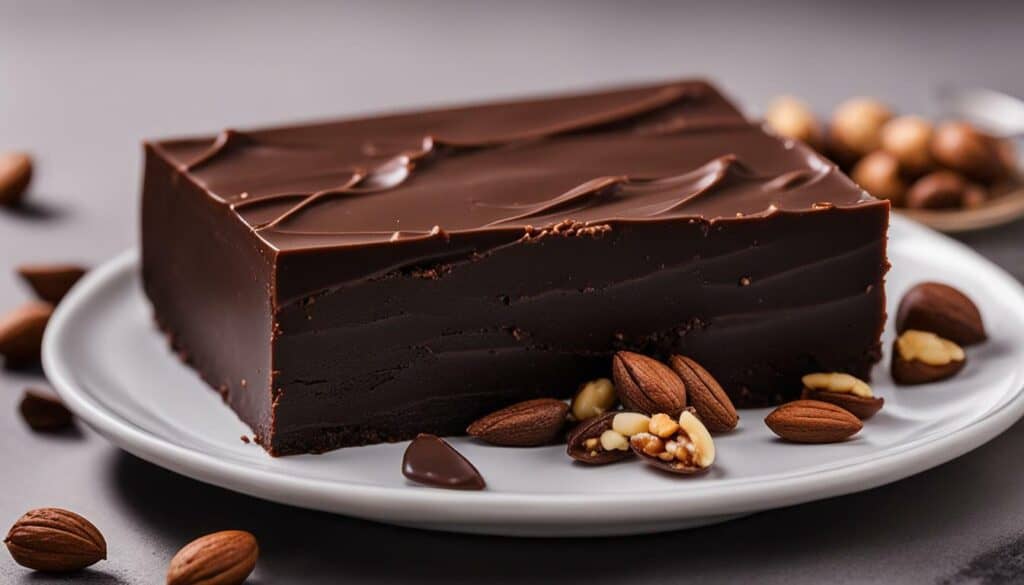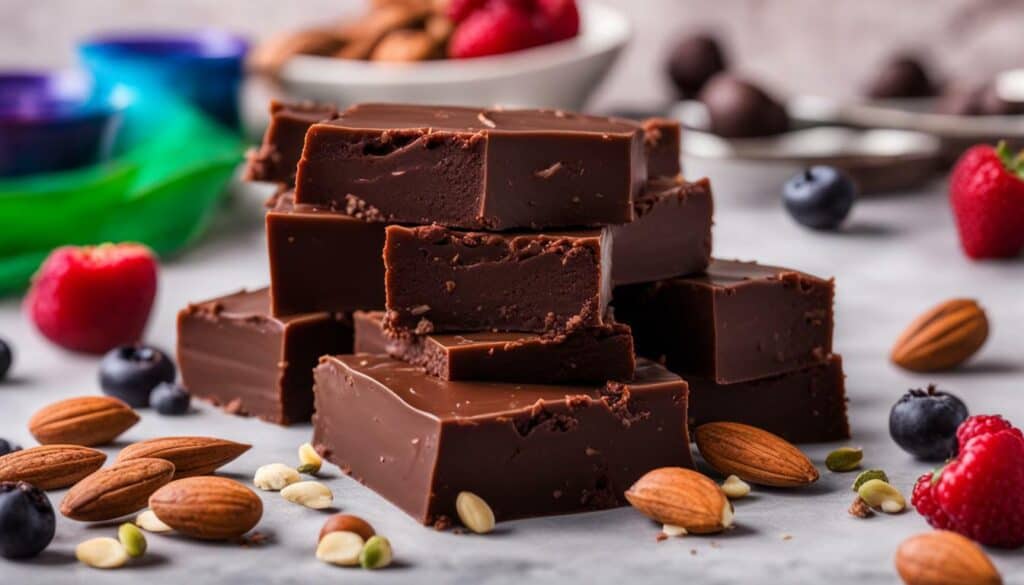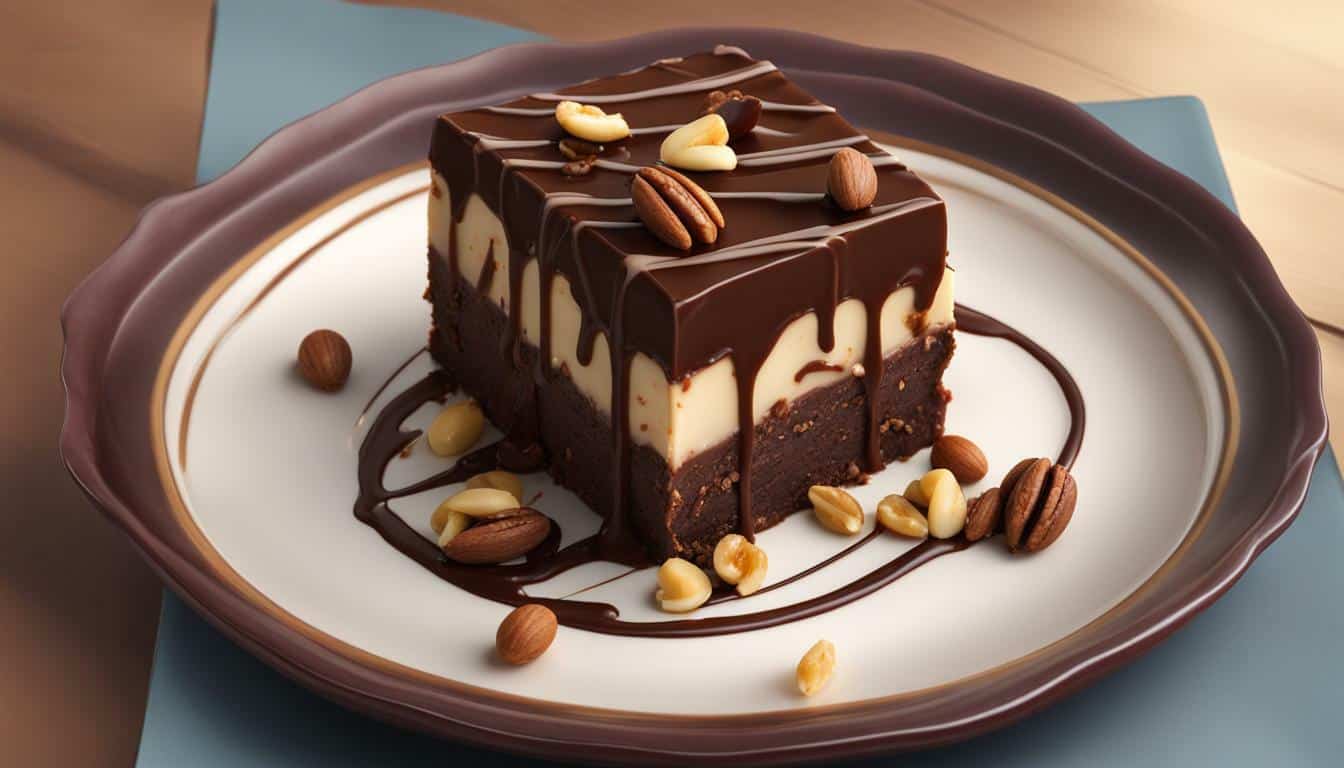Indulging in a piece of chocolate fudge is like taking a bite of pure heaven. The rich, creamy texture and irresistible sweetness make it a favorite treat for many. But have you ever wondered just how many calories are in this decadent delight?
When it comes to the calorie content of chocolate fudge, there are a few factors to consider. On average, a small piece weighing around 1 ounce contains approximately 110-120 calories. However, this number can vary depending on the recipe and serving size. If you opt for fudge with additional ingredients like nuts, caramel, or marshmallows, the calorie count can increase.
Traditional fudge recipes often involve cooking sugar, butter, and milk to a specific temperature. While this creates the creamy texture and rich flavor we all love, it also contributes to a higher calorie count. That’s why it’s important to be mindful of portion control when indulging in chocolate fudge.
Key Takeaways:
- The calorie content of chocolate fudge can vary depending on the recipe and serving size.
- On average, a small piece of chocolate fudge weighs around 1 ounce and contains approximately 110-120 calories.
- The calorie count can increase if the fudge is made with additional ingredients like nuts, caramel, or marshmallows.
- Traditional fudge recipes often involve cooking sugar, butter, and milk, resulting in a higher calorie content.
- It’s important to practice portion control when enjoying chocolate fudge to manage calorie intake.
Now that we’ve uncovered the calorie content of chocolate fudge, let’s delve deeper into exploring the average calorie count, factors influencing the calorie count, and how to make healthier choices without sacrificing taste. Join me on this delightful journey as we unlock the secrets behind chocolate fudge calories!
Exploring the Average Calorie Content of Chocolate Fudge
Chocolate fudge comes in various forms, but on average, how many calories can we expect to find in this delightful confection? The calorie content of chocolate fudge can vary depending on the recipe and serving size, but on average, a small piece weighing around 1 ounce contains approximately 110-120 calories. However, the calorie content can increase if the fudge is made with additional ingredients such as nuts, caramel, or marshmallows. Traditional fudge recipes often involve cooking sugar, butter, and milk to a specific temperature, which can contribute to a higher calorie count. It’s important to be mindful of portion control when enjoying chocolate fudge.
To gain a better understanding of the calorie content in chocolate fudge, let’s take a closer look at a table that outlines the average calorie ranges for different serving sizes:
| Serving Size | Calories |
|---|---|
| 1 ounce (28 grams) | 110-120 |
| 2 ounces (56 grams) | 220-240 |
| 4 ounces (113 grams) | 440-480 |
As you can see from the table, the calorie content of chocolate fudge increases as the serving size goes up. It’s important to keep this in mind when indulging in this sweet treat. If you’re watching your calorie intake, opting for a smaller piece can help satisfy your cravings without going overboard.
While chocolate fudge can be a delicious treat, it’s essential to be mindful of your overall calorie intake and make informed choices. Enjoying a small piece of chocolate fudge as an occasional indulgence can be a delightful way to satisfy your sweet tooth while maintaining a balanced lifestyle.

It’s time to dive deeper and uncover the factors that contribute to the calorie count of chocolate fudge. While the average calorie content of a small piece of chocolate fudge weighing around 1 ounce hovers around 110-120 calories, it’s important to remember that this can vary based on different factors like serving size and additional ingredients.
A traditional fudge recipe typically includes sugar, butter, and milk, which can add up in terms of calories. These ingredients are cooked to a specific temperature to achieve the desired texture, resulting in a rich and indulgent treat but also a higher calorie count. If you’re looking to keep the calorie content in check, it’s worth considering alternative recipes that use healthier substitutes for these ingredients.
Additional ingredients like nuts, caramel, or marshmallows can also impact the calorie content of chocolate fudge. While they can add extra flavor and texture, they can also contribute to a higher calorie count. It’s important to be aware of these additional ingredients and the impact they have on the overall calorie content.
| Ingredients | Calories per Serving |
|---|---|
| Classic Chocolate Fudge | 120-150 |
| Walnut Fudge | 130-170 |
| Marshmallow-Filled Fudge | 140-180 |
As you can see from the table above, the calorie range can vary depending on the type of chocolate fudge. It’s important to consider these variations when managing your calorie intake and making informed choices about portion sizes. Remember, moderation is key when it comes to enjoying chocolate fudge without overindulging.
Now that we’ve explored the factors that influence the calorie count of chocolate fudge, let’s move on to deconstructing traditional fudge recipes. We’ll uncover ways to create healthier versions of this beloved treat without compromising on taste.
Deconstructing Traditional Fudge Recipes
Traditional fudge recipes may be delicious, but they can pack a calorie punch. The combination of sugar, butter, and milk in these recipes contributes to a higher calorie count. However, if you’re looking to indulge in fudge while being mindful of your calorie intake, there are ways to create healthier versions that still satisfy your sweet tooth.
One approach to making low-calorie chocolate fudge is to substitute some of the traditional ingredients with healthier alternatives. For example, you can replace the butter with unsweetened applesauce or mashed bananas, which reduces the calorie content while adding natural sweetness. Additionally, using a low-calorie sweetener instead of granulated sugar can significantly reduce the calorie count without sacrificing taste.
Another option is to experiment with different types of chocolate. Dark chocolate contains less sugar and more cocoa solids than milk chocolate, making it a healthier choice. Opting for dark chocolate with a high percentage of cocoa can add depth of flavor to your fudge while reducing the overall calorie content.
To give you a taste of a low-calorie chocolate fudge recipe, here’s one you can try:
| Ingredients: | Quantity: |
|---|---|
| Dark chocolate (70% cocoa) | 6 ounces |
| Unsweetened almond milk | 1/2 cup |
| Low-calorie sweetener (e.g., stevia) | 1/4 cup |
| Vanilla extract | 1 teaspoon |
| Salt | 1/4 teaspoon |
| Chopped nuts (optional) | 1/4 cup |
Instructions:
- In a microwave-safe bowl, melt the dark chocolate in 30-second intervals, stirring in between until smooth.
- In a separate microwave-safe bowl, heat the almond milk for 30 seconds or until warm.
- Add the warm almond milk, low-calorie sweetener, vanilla extract, and salt to the melted chocolate. Stir until well combined.
- If desired, fold in the chopped nuts for added texture.
- Pour the mixture into a lined baking dish and spread it evenly.
- Refrigerate for at least 2 hours or until firm.
- Cut into small squares and enjoy!
With this recipe, you can indulge in a guilt-free chocolate fudge experience while keeping your calorie intake in check. Remember, moderation is still key even with low-calorie options, so savor each bite mindfully and enjoy the sweet satisfaction in a healthier way.

Adhering to a sensible portion size is key to savoring every bite of chocolate fudge guilt-free. While this delectable treat can be hard to resist, it’s important to be mindful of your calorie intake. By practicing portion control, you can enjoy the indulgence without derailing your healthy lifestyle.
So, how do you determine the appropriate portion size for chocolate fudge? It’s helpful to use a chocolate fudge calorie calculator, which can provide a guideline based on the specific recipe or brand you’re consuming. Remember that the calorie count can vary depending on the size and ingredients of the fudge.
One way to practice portion control is to divide the fudge into smaller pieces and savor them slowly. This not only helps in controlling your calorie intake but also allows you to fully enjoy the rich flavors and textures of the fudge. Another tip is to pair your chocolate fudge with a serving of fresh fruit or a cup of tea, which can help satisfy your sweet tooth and prevent overindulgence.
| Portion Size | Calories |
|---|---|
| 1 ounce (28g) | 110-120 |
| 1 square (1.5 inches) | approximately 60 |
| 2-inch piece | approximately 90 |
Remember, portion control doesn’t mean depriving yourself of chocolate fudge. It’s about enjoying it in moderation and being aware of your calorie intake. By practicing portion control and making mindful choices, you can still savor this delightful treat while maintaining a balanced lifestyle.

Chocolate fudge may be a decadent treat, but are there any upsides to indulging in this delectable delight? Let’s explore the nutritional benefits and downsides of this beloved confection.
When it comes to chocolate fudge, one of the positive aspects is the presence of antioxidants. Dark chocolate, the main ingredient in most fudge recipes, contains higher levels of antioxidants compared to milk chocolate. These antioxidants, known as flavonoids, have been linked to various health benefits such as reducing inflammation and improving heart health. So, enjoying a small piece of chocolate fudge can provide a dose of these beneficial compounds.
However, it’s important to be mindful of the potential downsides of consuming chocolate fudge. One of the main concerns is its sugar content. Fudge recipes typically include a significant amount of sugar, which can contribute to weight gain, tooth decay, and an increased risk of developing chronic conditions like diabetes and heart disease. Additionally, fudge often contains saturated fat from ingredients like butter and cream, which can raise cholesterol levels when consumed in excess.
It’s crucial to enjoy chocolate fudge in moderation and make it a part of an overall balanced diet. By being mindful of portion sizes and making healthier choices in your daily meals, you can still savor this scrumptious treat without compromising your health.
So, what’s the verdict? While chocolate fudge may not be a health food, it does offer some nutritional benefits, particularly when made with dark chocolate. However, the key lies in moderation and balance. Indulge in a piece or two of chocolate fudge occasionally, savoring each bite, and pair it with a nutritious diet consisting of fruits, vegetables, lean proteins, and whole grains to maintain overall well-being.

| Nutrient | Amount per 1 oz (28g) serving |
|---|---|
| Calories | 110-120 |
| Total Fat | 4-5g |
| Saturated Fat | 2-3g |
| Carbohydrates | 18-20g |
| Sugar | 14-16g |
| Protein | 1-2g |
Remember, moderation is key. Enjoy your chocolate fudge in small portions, savoring each mouthful, and balance it out with a healthy lifestyle for guilt-free indulgence.
Tips for Making Healthier Chocolate Fudge Choices
Craving chocolate fudge but want to keep your calorie count in check? We’ve got you covered with some smart choices and a delicious recipe. By making a few simple modifications to traditional fudge recipes, you can enjoy a healthier version of this indulgent treat without compromising on taste.
Firstly, consider using dark chocolate instead of milk chocolate. Dark chocolate contains less sugar and more antioxidants, making it a healthier choice. Look for a dark chocolate with a cocoa content of 70% or higher for maximum benefits.
Secondly, you can swap out some of the sugar and butter in the recipe with healthier alternatives. Try using natural sweeteners like honey or maple syrup instead of refined sugar. Additionally, you can use mashed bananas, unsweetened applesauce, or Greek yogurt as a substitute for butter to reduce the overall calorie content.

| Ingredients | Amount |
|---|---|
| Dark chocolate (70% cocoa or higher) | 8 ounces |
| Honey or maple syrup | 1/4 cup |
| Unsweetened almond milk | 1/4 cup |
| Cocoa powder | 2 tablespoons |
| Vanilla extract | 1 teaspoon |
| Pinch of salt | |
| Chopped nuts (optional) |
“This low-calorie chocolate fudge is rich in flavor and perfect for satisfying your sweet tooth. The dark chocolate adds depth and the natural sweeteners provide a touch of sweetness without the excess calories. Feel free to customize it by adding your favorite nuts for an extra crunch!”
To prepare the low-calorie fudge, start by melting the dark chocolate in a heatproof bowl over simmering water. Stir in the honey or maple syrup, almond milk, cocoa powder, vanilla extract, and a pinch of salt. Once well combined, pour the mixture into a lined baking dish and sprinkle chopped nuts on top if desired. Refrigerate for a few hours until firm, then cut into small squares and enjoy.
With these tips and a delectable low-calorie recipe, you can indulge in chocolate fudge while still making healthier choices. Remember, moderation is key, so savor each bite and enjoy the sweet pleasure guilt-free!
Frequently Asked Questions about Chocolate Fudge Calories (FAQ)
As a chocolate lover, you may be curious about the calorie content of chocolate fudge. Here are some frequently asked questions to help you navigate the world of chocolate fudge calories:
- How many calories are in chocolate fudge?
The calorie content of chocolate fudge can vary depending on the recipe and serving size. On average, a small piece weighing around 1 ounce contains approximately 110-120 calories.
- Does the calorie content change if I add nuts, caramel, or marshmallows to my fudge?
Yes, adding additional ingredients such as nuts, caramel, or marshmallows can increase the calorie count of chocolate fudge. It’s important to consider these extras when calculating your calorie intake.
- Are there healthier versions of chocolate fudge with lower calorie content?
Absolutely! Traditional fudge recipes often involve cooking sugar, butter, and milk, which can contribute to a higher calorie count. However, there are ways to create healthier versions of fudge with lower calorie content by using alternative ingredients and reducing sugar and fat.
- How can I practice portion control when enjoying chocolate fudge?
Mindful eating and portion control are essential when indulging in chocolate fudge. It’s important to be aware of your portion sizes and avoid overindulging. Try cutting your fudge into smaller pieces or savoring a small serving to manage your calorie intake.
- What are the potential downsides of consuming chocolate fudge?
While chocolate fudge can be a delicious treat, it’s important to be mindful of the potential downsides. Consuming too much sugar and saturated fat can have negative effects on your health. It’s best to enjoy chocolate fudge in moderation as part of a balanced diet.
Now that you have a better understanding of chocolate fudge calories, you can make informed choices and enjoy this delectable treat without guilt. Remember, moderation is key and savoring each bite is part of the sweet pleasure!

Indulging in chocolate fudge can be a guilt-free pleasure with a little knowledge and a lot of moderation. As we’ve explored throughout this article, the calorie content of chocolate fudge can vary depending on the recipe and serving size. On average, a small piece weighing around 1 ounce contains approximately 110-120 calories. However, if you add ingredients like nuts, caramel, or marshmallows, the calorie count can increase.
Traditional fudge recipes often involve cooking sugar, butter, and milk to a specific temperature, resulting in a higher calorie content. But fear not! There are ways to enjoy chocolate fudge while being mindful of your calorie intake.
One key strategy is portion control. By understanding appropriate serving sizes and practicing mindful eating, you can savor this delightful treat without overindulging. Remember, moderation is key.
To help you make healthier choices, we’ve provided a low-calorie chocolate fudge recipe. This alternative uses ingredients that are lower in calories but still offers a deliciously satisfying taste. Give it a try and satisfy your chocolate cravings without derailing your healthy lifestyle.
So go ahead and enjoy the occasional piece of chocolate fudge, knowing that with a little moderation, you can savor this indulgence guilt-free. Treat yourself, and remember that balance is the key to maintaining a healthy lifestyle.

| Ingredients | Amount |
|---|---|
| Dark chocolate (70% cocoa) | 8 ounces |
| Coconut oil | 2 tablespoons |
| Honey or maple syrup | 2 tablespoons |
| Vanilla extract | 1 teaspoon |
| Salt | 1/8 teaspoon |
- Melt the dark chocolate and coconut oil together in a heatproof bowl over simmering water.
- Remove from heat and stir in the honey or maple syrup, vanilla extract, and salt.
- Pour the mixture into a lined baking dish and spread evenly.
- Refrigerate for at least two hours, or until firm.
- Once firm, cut into small squares and enjoy!
With this recipe, you can satisfy your chocolate fudge cravings while reducing the calorie content. Enjoy in moderation, and savor the sweet delight of guilt-free chocolate fudge!
Exploring the Calorie Range for Different Types of Chocolate Fudge
Not all chocolate fudges are created equal when it comes to calorie content. Let’s take a closer look at the range for different variations. The calorie count can vary based on the ingredients and preparation methods used. Here are some popular types of chocolate fudge and their respective calorie ranges:
| Type of Chocolate Fudge | Calorie Range per 1 ounce (approx.) |
|---|---|
| Classic Chocolate Fudge | 110-120 calories |
| Walnut Fudge | 120-140 calories |
| Marshmallow-Filled Fudge | 130-150 calories |
These ranges are approximate and can vary depending on the specific recipe and serving size. It’s important to note that the calorie content of chocolate fudge can increase if additional ingredients such as nuts, caramel, or marshmallows are added. It’s always a good idea to check the packaging or recipe to get a more accurate estimate of the calorie count.
Indulging in Moderation
While chocolate fudge can be a delicious treat, it’s essential to enjoy it in moderation, considering its calorie content. One strategy is to cut smaller portion sizes to limit your calorie intake. Another approach is to opt for healthier versions of fudge, such as those made with alternative sweeteners or lower-fat ingredients. By making mindful choices and being aware of the calorie content, you can still satisfy your sweet tooth without derailing your healthy eating habits.

Remember, variety is key when it comes to maintaining a balanced diet. While chocolate fudge can be enjoyed on occasion, it’s essential to incorporate a wide range of nutritious foods into your daily meals. By practicing portion control and making informed choices, you can still enjoy the occasional indulgence without compromising your health goals.
Savvy Ways to Enjoy Chocolate Fudge in Moderation
Want to enjoy chocolate fudge without feeling guilty? I have some savvy tips just for you. While chocolate fudge might not be the healthiest treat, there are ways to indulge in moderation and make smarter choices that can satisfy your cravings while keeping your calorie intake in check.
1. Opt for a Small Portion Size: Instead of indulging in a large piece of chocolate fudge, try cutting it into smaller, bite-sized portions. This will help you enjoy the rich flavors without consuming excessive calories.
2. Make a Lower-Calorie Recipe: If you love making homemade fudge, consider using alternative ingredients to reduce the calorie content. Replace some of the butter and sugar with healthier options like applesauce or mashed bananas. You can also experiment with using dark chocolate, which has a higher cocoa content and offers potential health benefits.
3. Mix in Nutritious Additions: Enhance the nutritional value of your chocolate fudge by adding ingredients like chopped nuts or dried fruit. Not only will this provide a satisfying crunch and burst of flavor, but it will also introduce essential nutrients such as healthy fats and fiber.
4. Balance With Physical Activity: Remember, enjoying a piece of chocolate fudge doesn’t mean you have to skip your workout. Incorporate regular exercise into your routine to help offset any indulgences and maintain a healthy balance. Whether it’s going for a brisk walk, hitting the gym, or engaging in your favorite physical activity, staying active is key to a well-rounded lifestyle.

By implementing these savvy tips, you can savor your favorite chocolate fudge without compromising your health goals. Remember, it’s all about moderation and making conscious choices that align with your overall well-being. Enjoy your sweet treat guilt-free!
Conclusion
In conclusion, chocolate fudge can be enjoyed sensibly by being mindful of portion sizes, making healthier choices, and embracing moderation. Chocolate fudge is undeniably a delightful treat that brings joy to many, but it’s important to be aware of its calorie content to maintain a balanced lifestyle.
On average, a small piece of chocolate fudge weighing around 1 ounce contains approximately 110-120 calories. However, it’s essential to note that the calorie content can vary based on the recipe and serving size. If the fudge is made with additional ingredients like nuts, caramel, or marshmallows, the calorie count can increase.
Traditional fudge recipes involve cooking a combination of sugar, butter, and milk to a specific temperature, which contributes to a higher calorie content. Therefore, it is crucial to exercise portion control when enjoying chocolate fudge to manage calorie intake and prevent overindulgence.
By making healthier choices and embracing moderation, you can still savor this indulgent delight without derailing your healthy lifestyle. Remember to be mindful of portion sizes and consider experimenting with low-calorie recipes and ingredient substitutes to create a guilt-free chocolate fudge experience.
FAQ
Q: How many calories are in a small piece of chocolate fudge?
A: On average, a small piece of chocolate fudge weighing around 1 ounce contains approximately 110-120 calories.
Q: Can the calorie content of chocolate fudge vary?
A: Yes, the calorie content can vary based on the recipe and serving size. Additional ingredients like nuts, caramel, or marshmallows can increase the calorie count.
Q: Why do traditional fudge recipes have a higher calorie count?
A: Traditional fudge recipes often involve cooking sugar, butter, and milk to a specific temperature, which contributes to a higher calorie count.
Q: How important is portion control when enjoying chocolate fudge?
A: Portion control is crucial to manage calorie intake. Being mindful of portion sizes helps to enjoy chocolate fudge without overindulging.
Q: Are there any nutritional benefits to chocolate fudge?
A: While chocolate fudge is not a health food, dark chocolate contains antioxidants. However, consuming too much sugar and saturated fat can have downsides.
Q: Do you have any tips for making healthier chocolate fudge choices?
A: Yes, we have ideas for healthier ingredient substitutes and a low-calorie chocolate fudge recipe for you to try.
Q: What is the calorie range for different types of chocolate fudge?
A: Different types of chocolate fudge can have varying calorie content. We’ll explore the calorie ranges for classic chocolate fudge, walnut fudge, and marshmallow-filled fudge.
Q: How can I enjoy chocolate fudge in moderation?
A: We’ll provide some savvy ways to enjoy your favorite treat without going overboard on calories.





Leave a Reply